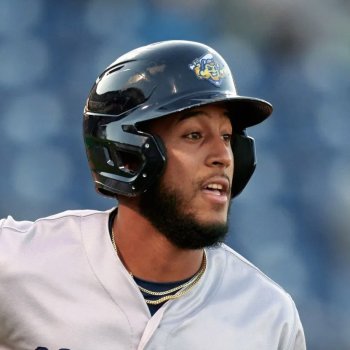
Twins Video
Back in October, I wrote about the righty's heater, which measured up against some of the game's best in 2016. A glance at what others on that list managed to achieve on the mound is beyond encouraging. Among those who were able to throw that hard while avoiding tons of walks, there was basically universal success. Hitters aren't going to do much with consistent 97 MPH fastballs that find the zone, especially if there's any secondary pitch to play them up.
Chargois has that: a hard slider that registers in the upper-80s and keeps hitters from keying on his red-hot fastball. He also has shown the ability to keep both in the zone, though that wavers. His command certainly wasn't there in a disastrous MLB debut last June that saw him cough up five earned runs while recording only two outs and throwing less than half of his 30 pitches for strikes.
Ask the righty about that Saturday afternoon, and his easygoing smile evaporates.
"That kind of performance is not acceptable," Chargois said. "I don’t feel like that’s who I am, it’s not what I’m about."
What went wrong?
"Everything. Your dream’s coming true right in front of your eyes, and I have to do my job? That seems impossible."
The moment Chargois had long dreamed of quickly turned into a nightmare as a loaded Red Sox lineup turned a one-run ninth-inning lead into a blowout. Following a brilliant two-month run in the minors that earned him his promotion, he couldn't find any answers. The 25-year-old faced eight batters and six reached base as a carousel spun around him on the Target Field mound: three singles, two walks, a hit batsman, a run-scoring wild pitch.
Immediately after the game, he was optioned back to the minors. In Rochester, he picked up where he left off by limiting hits, missing bats and – most importantly – throwing strikes. In 17 outings after returning to the Red Wings, he walked only four of 93 batters faced. Two months later, he was back up in the big leagues and this time he was ready to show what he was about.
Appearing 24 times the rest of the way, he posted a 2.82 ERA, and finished strong by allowing just one run on six hits in his final 13 trips to the hill.
The impressive rebound put Chargois in a position where he now has a very realistic shot at winning a bullpen job this spring. But unsurprisingly, the manager wants to see more consistency and efficiency.
"We saw a little bit of both sides of that last year," Paul Molitor noted. "Strike thrower and aggressive, and the results were usually pretty good. And other times, you look up and he’s at 28 pitches to get through an inning."
This issue has nagged at Chargois at times in Grapefruit League play. Last Monday, he came on in relief of starter Justin Haley in the third inning and got two quick strikeouts, but things began to drag with several deep counts and an HBP before he finally wrapped it up.
"We had him slated to pitch two today," Molitor said afterward, "but he had a long inning, so I didn’t send him back out there for just seven or eight pitches."
Pitch economy was rarely a problem for Chargois after he made it his focus last year. Following that clunker debut, he averaged fewer than five pitches per out recorded the rest of the way, in both the minors and majors. That's where he wants to live. If he does, he can certainly set his sights on a late-inning role – perhaps the most coveted one.
Glen Perkins is destined to start the year on the shelf. While there is a general assumption that incumbent Brandon Kintzler will open as closer, Molitor has been reluctant to make that official. "I'm not going there yet," the skipper responded when I asked him about it last weekend.
One wonders if the door is being left open for Chargois. In one sense, his level of experience lags behind guys like Kintzler and Ryan Pressly, who've spent much more time in the majors. But in another sense, he has a significant edge.
Kintzler had never recorded a big-league save prior to 2016 and his pitch repertoire is hardly tailored to the gig, though he performed admirably when called upon last summer. Pressly brings gas but has no closing experience and Molitor seems disinclined to mess with the setup role where he proved capable.
Chargois, meanwhile, is a closer through and through. He dominated in that capacity as a junior for Rice University, and in the Cape Cod League, before the Twins made him the 72nd overall draft pick in 2012. Though he was selected during a time period where Minnesota was infatuated with trying to turn collegiate relievers into starters (they did so with Rice co-closer Tyler Duffey, whom they drafted three rounds later), there were never such inklings with Chargois.
After signing, he went to Elizabethton and closed. Injuries cost him the next two seasons, but when he returned in 2015 he went to Fort Myers and closed, then moved up to Chattanooga and did the same. Last year, he recorded 16 saves in Double-A and Triple-A. So it was fitting that his ill-fated first taste of the majors came in the ninth inning.
Sooner or later, it feels inevitable that Chargois will own the final frame for the Twins. And if the precedents set by other MLB closers who bring velocity in the same range – such as Aroldis Chapman, Craig Kimbrel, Edwin Diaz and Ken Giles – are any indication, he could become one of the league's best.
But before he lands the job, he must prove that he can tame that big heat, and the key to doing so might be keeping his cool. Luckily, that seems to come naturally to Chargois.
MORE FROM TWINS DAILY
— Latest Twins coverage from our writers
— Recent Twins discussion in our forums
— Follow Twins Daily via Twitter, Facebook or email
— Become a Twins Daily Caretaker






Recommended Comments
Join the conversation
You can post now and register later. If you have an account, sign in now to post with your account.
Note: Your post will require moderator approval before it will be visible.